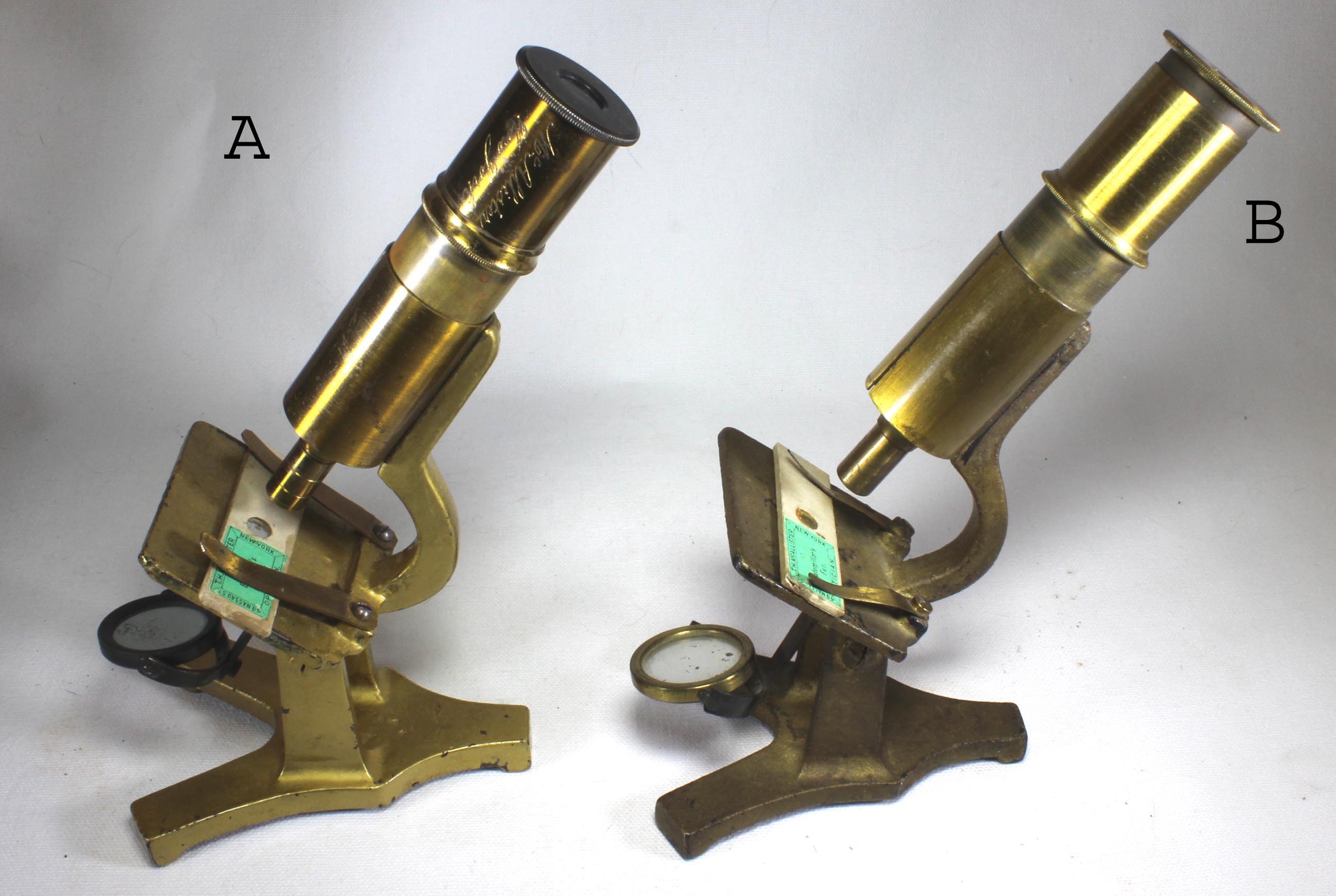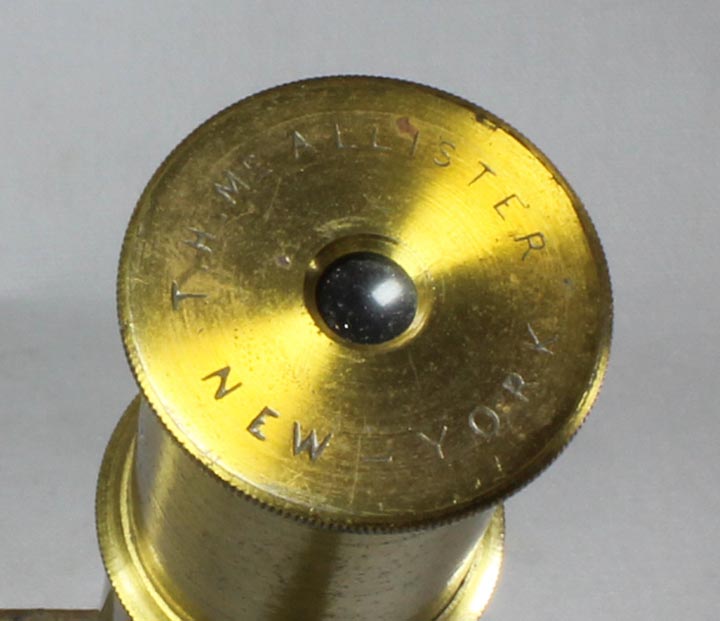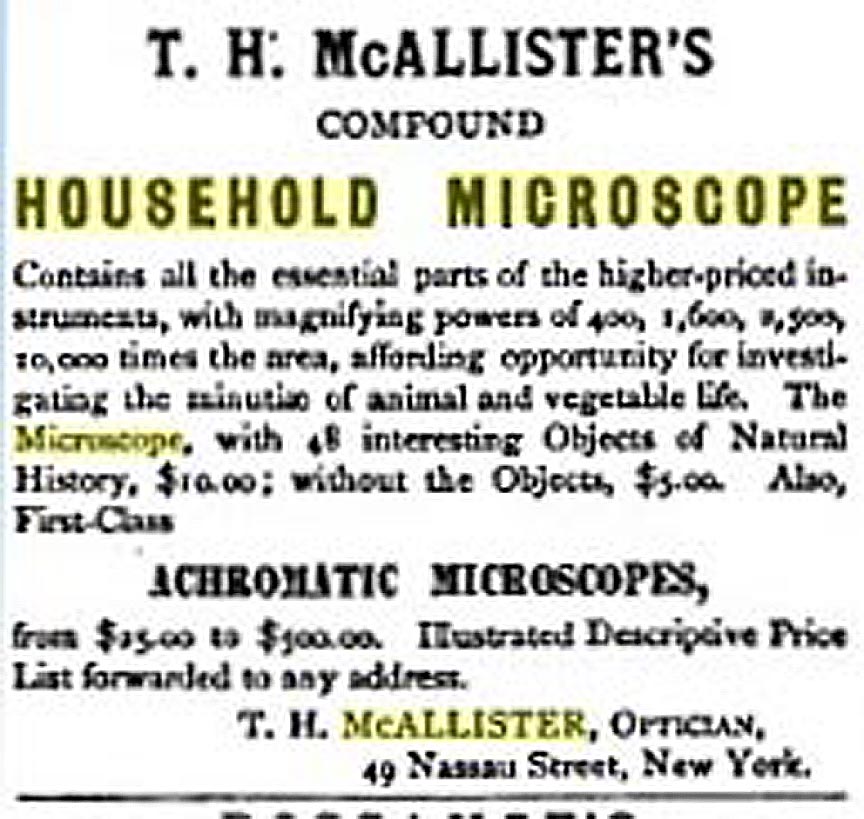MICROSCOPE-ANTIQUES.COM © 2013-15.
THE (ORIGINAL) HOUSEHOLD MICROSCOPE
c. 1867-?
SIGNED: T. H. McAllister
SERIAL NUMBER: none
MODEL: HOUSEHOLD
DESCRIPTION:

 There are two T.H. McAllister Household Microscopes in this collection.
They are virtually identical except for the signatures, and slight
differences in the finishes. In the image shown to the left, 'A' is
signed in script on the tube 'McAllister, New York' and also in block letters on the front of the sleeve as 'T.H. McAllister
New-York'. The signature on the sleeve is not only in block letters,
but appears to be stamped rather than engraved like the tube signature.
(A similar microscope with only the block signature on the sleeve,
without the engraved signature on the tube is also known). The
signature on 'B' is found only in block letters on the eyepiece as
'T.H. McAllister New York'. This signature is shown to the right of this paragraph.
There are two T.H. McAllister Household Microscopes in this collection.
They are virtually identical except for the signatures, and slight
differences in the finishes. In the image shown to the left, 'A' is
signed in script on the tube 'McAllister, New York' and also in block letters on the front of the sleeve as 'T.H. McAllister
New-York'. The signature on the sleeve is not only in block letters,
but appears to be stamped rather than engraved like the tube signature.
(A similar microscope with only the block signature on the sleeve,
without the engraved signature on the tube is also known). The
signature on 'B' is found only in block letters on the eyepiece as
'T.H. McAllister New York'. This signature is shown to the right of this paragraph.
The microscope arises from a 'V'-shaped foot on two uprights cast into
the foot. The flat single-sided gimbaled mirror is fixed to a swinging
tailpiece attached under the stage. Two stage clips are screwed to the
top of the stage. There is a drawtube which allows varying the
magnification. The focus is Push-pull. There is no fine focus. Two
slides with T.H. McAllister's label are shown on the microscopes. The
eyepiece screws in to the top of the tube and the objective screws into
the bottom and is not divisible. Note that on one microscope the
objective has a single score and on the other it has two. These are
different powers.
HISTORY
Thomas Hamilton (T.H.) McAllister is the only member of the the
McAllister family who actually made (or at least designed),
microscopes. The McAllister family in America dates back to the 1700's
when John McAllister Sr emigrated from Scotland about 1775. He became a
successful businessman in Philadelphia, selling whips and canes.
Starting in 1796, he added spectacles to his business, and the
Philadelphia optical business of McAllister started. The family
business was based at various addresses on Chestnut Street in
Philadelphia for the next hundred years or so. John Jr apparently
continued the business and had ten children. Among these were William
Young (W.Y.) and T.H. McAllister. W.Y. had nine children, one of whom
was Frances Wardale (F.W.) McAllister. The business underwent several
name changes over the years, as the various principals in the business
changed. W. Y. joined the firm about 1830.
In 1836 the principals included James W. Queen. By 1853 T.H. joined W.Y. and Queen had left to form his own business.
In 1838 T.H. was approached to obtain a microscope for the United
States Exploring expedition. To his dismay, no American makers or
dealers could supply a satisfactory microscope, and eventually a French
import was obtained from Dr Paul Goddard. Nevertheless, he himself did
not attempt microscope manufacture until about 1867.
 In 1865 T.H. left the Philadelphia firm and moved to New York City. It
was two years later in 1867 that he made his first microscope, the
'Household' Model. In 1876 at $5 it was one of the least expensive
compound microscope available in America. His design was elegant in its
simplicity and he reduced cost by making the foot, limb and stage of
painted cast iron. The only brass parts were the sleeve holding the
optical tube, the tube itself, and the objectives. He promoted it as an
alternative to the cheap French imports which were poorly made and were
not of Lister limb construction. It appears that his initial efforts
were nonachromatic instruments, as he advertised in 1876 that the
objectives were made of 'Crown Glass' and he did not mention
achromatism. Furthermore, an advertisement for his microscopes, as
shown here to the right, made it very clear that the 'Household' Model
was not achromatic, as achromatic instruments were listed separately.
In 1865 T.H. left the Philadelphia firm and moved to New York City. It
was two years later in 1867 that he made his first microscope, the
'Household' Model. In 1876 at $5 it was one of the least expensive
compound microscope available in America. His design was elegant in its
simplicity and he reduced cost by making the foot, limb and stage of
painted cast iron. The only brass parts were the sleeve holding the
optical tube, the tube itself, and the objectives. He promoted it as an
alternative to the cheap French imports which were poorly made and were
not of Lister limb construction. It appears that his initial efforts
were nonachromatic instruments, as he advertised in 1876 that the
objectives were made of 'Crown Glass' and he did not mention
achromatism. Furthermore, an advertisement for his microscopes, as
shown here to the right, made it very clear that the 'Household' Model
was not achromatic, as achromatic instruments were listed separately.
The 'Household Microscope' was very successful and the idea was
copied by many retailers, most of whom imported their own versions from
France. It is said that eventually even T.H. himself could not compete
with the French versions, and imported his own as well, though I have
never seen a T.H. McAllister microscope of French manufacture. W.Y. on
the other hand, although giving credit to T.H., eventually sold his own
imported version, made by the same manufacturer as the 'Household' and
'Universal' microscopes sold by R & J Beck, Walmsley, and Queen. In
fact the optical tubes, eyepieces and objectives of the household-type
microscopes sold by all four of these retailers are absolutely
identical in every detail. It is only the design of the foot and limb
that differs much between them.
About 1870 F.W. joined his father W.Y. in the Philadelphia business
where the opticians concentrated on spectacles and sold microscopes,
but only those only made by others, including Thomas, now in New York.
About 1880 F.W. moved to Baltimore to form his own company. This
company sold a large variety of things including drawing and surveying
instruments and microscopes but became known for their spectacles and
optometry equipment. F.W. belonged to microscopical organizations, and
sold microscopes, but never manufactured any, to the best of our
knowledge.
Back in Philadelphia, William Y. remained active. His 1867
'Catalog of Optical and Philosophical Instruments' included French
Microscopes, Zentmayer's Microscopes, and Tolles objectives; Thomas's
microscopes were not yet mentioned. Eventually, W.Y. advertised that he
sold 'T. H. McAllister's Achromatic Household Microscope' which, as
noted above, he eventually imported from France. Despite giving credit
to his brother in the ads, the foot was signed 'Universal Microscope, Wm Y. McAllister, Phila'.
I have not been able to locate a catalog showing Thomas H McAllister's microscopes for sale by his older brother in Philadelphia, although one
would assume this to be the case.
The New York firm of T.H. McAllister, founded by the inventer of the Household Microscope went out of business in the 1890's, after producing microscopes for over twenty years.

 There are two T.H. McAllister Household Microscopes in this collection.
They are virtually identical except for the signatures, and slight
differences in the finishes. In the image shown to the left, 'A' is
signed in script on the tube 'McAllister, New York' and also in block letters on the front of the sleeve as 'T.H. McAllister
New-York'. The signature on the sleeve is not only in block letters,
but appears to be stamped rather than engraved like the tube signature.
(A similar microscope with only the block signature on the sleeve,
without the engraved signature on the tube is also known). The
signature on 'B' is found only in block letters on the eyepiece as
'T.H. McAllister New York'. This signature is shown to the right of this paragraph.
There are two T.H. McAllister Household Microscopes in this collection.
They are virtually identical except for the signatures, and slight
differences in the finishes. In the image shown to the left, 'A' is
signed in script on the tube 'McAllister, New York' and also in block letters on the front of the sleeve as 'T.H. McAllister
New-York'. The signature on the sleeve is not only in block letters,
but appears to be stamped rather than engraved like the tube signature.
(A similar microscope with only the block signature on the sleeve,
without the engraved signature on the tube is also known). The
signature on 'B' is found only in block letters on the eyepiece as
'T.H. McAllister New York'. This signature is shown to the right of this paragraph.  In 1865 T.H. left the Philadelphia firm and moved to New York City. It
was two years later in 1867 that he made his first microscope, the
'Household' Model. In 1876 at $5 it was one of the least expensive
compound microscope available in America. His design was elegant in its
simplicity and he reduced cost by making the foot, limb and stage of
painted cast iron. The only brass parts were the sleeve holding the
optical tube, the tube itself, and the objectives. He promoted it as an
alternative to the cheap French imports which were poorly made and were
not of Lister limb construction. It appears that his initial efforts
were nonachromatic instruments, as he advertised in 1876 that the
objectives were made of 'Crown Glass' and he did not mention
achromatism. Furthermore, an advertisement for his microscopes, as
shown here to the right, made it very clear that the 'Household' Model
was not achromatic, as achromatic instruments were listed separately.
In 1865 T.H. left the Philadelphia firm and moved to New York City. It
was two years later in 1867 that he made his first microscope, the
'Household' Model. In 1876 at $5 it was one of the least expensive
compound microscope available in America. His design was elegant in its
simplicity and he reduced cost by making the foot, limb and stage of
painted cast iron. The only brass parts were the sleeve holding the
optical tube, the tube itself, and the objectives. He promoted it as an
alternative to the cheap French imports which were poorly made and were
not of Lister limb construction. It appears that his initial efforts
were nonachromatic instruments, as he advertised in 1876 that the
objectives were made of 'Crown Glass' and he did not mention
achromatism. Furthermore, an advertisement for his microscopes, as
shown here to the right, made it very clear that the 'Household' Model
was not achromatic, as achromatic instruments were listed separately.